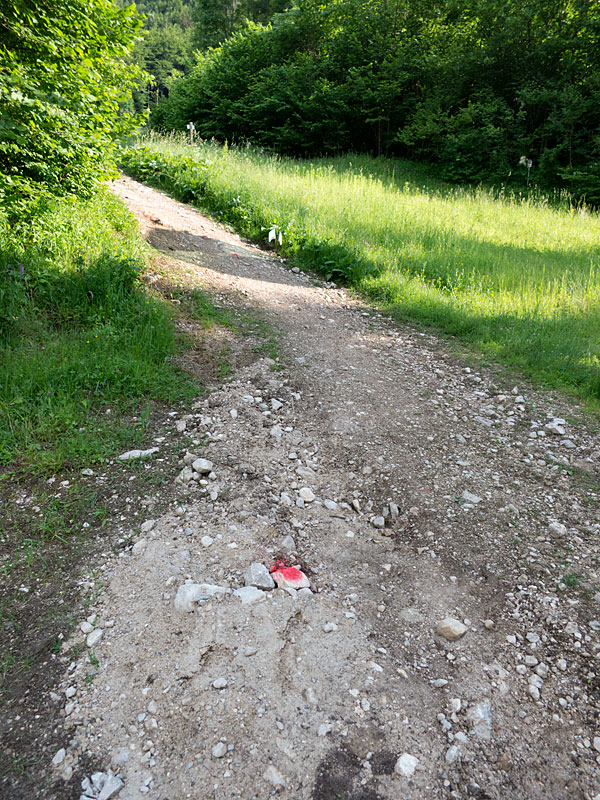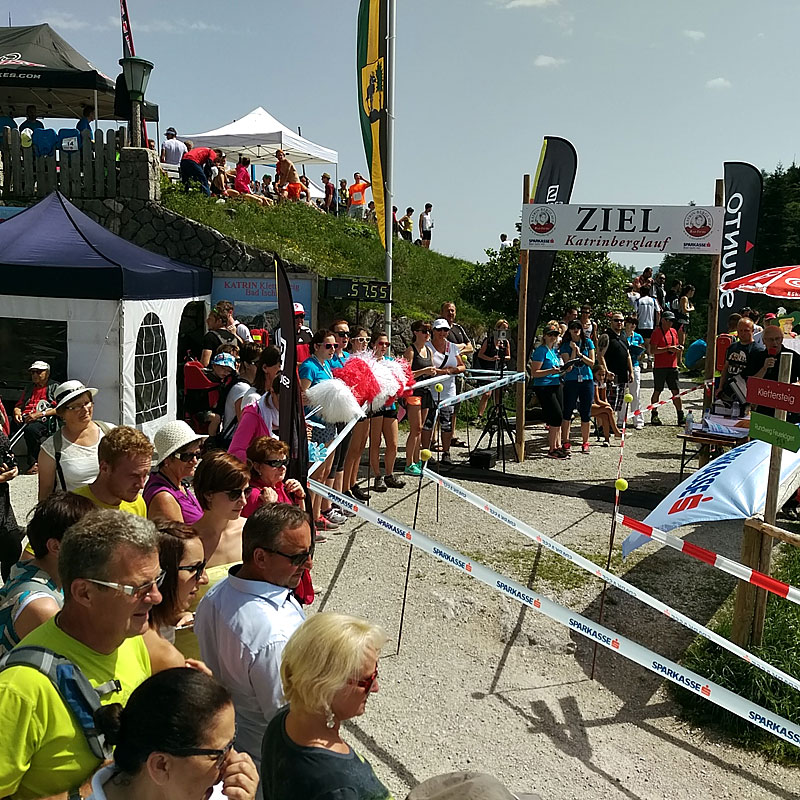Somewhere along the climb, there was that moment where everything just kind of faded away, and my entire mental focus was reduced to just that next footstep – to get that ideal foot placement, with the most grip and the least amount of slippage. Long gone were the ambitions of finishing in a certain time, long gone were the considerations of who to pass or whether I was about to get passed. Just that next step. And with enough steps, I’d make it across the finish line.
I had arrived in Bad Ischl, Austria the evening before. It had been an unremarkable 720km drive to get there, and I had enough daylight to still take a look at the race course. Of course whenever I’m in the mountains it’s easy to fall prey to the “just around the next corner” fallacy, so I walked quite far, up to the 2km marker for about 360m of elevation. I was sweating buckets even at a leisurely pace, and probably should have turned around sooner.
On race morning, I was able to get an early 7:15am breakfast at my hotel in nearby Bad Goisern and then drove about 8km to the starting line. I was early enough to get a decent parking spot; and proceeded to retrieve my racing bib. There was a small goodies bag included in the 20€ racing fee; which also included a finisher’s t-shirt, transport of a change of clothes to the finish line and the cable car ride down. That’s pretty good value for the money.
I did a quick warm-up on the first few hundred meters of the race course. My achilles tendon was not all that happy, and my heart rate was higher than normal; which was probably because I hadn’t slept well the previous night.
Shortly before 10:00, I joined over 200 runners behind the finish line. I picked a spot that I thought would correspond to my expected finishing time – somewhere half-way to two-thirds away from the fastest starters.

There was a count-down, and we were off. The first 300m past the Katrin-Seilbahn Talstation (cable station) and parking were on the paved Kaltenbachstrasse. The start was much quicker than I’m used to running as of recent (about 4min/km).

After about 300m, the race course turns right at a 90 angle and climbs up past a ski jump training place. The surface changed from paved to gravel as we met our first climb.


My heart rate was already at 170bpm 500m into the race as we turned right at another 90 angle. We were still in the shade, but fairly soon we’d lose that advantage. My run had already transformed into a fast walk. Most of the people around me were still running, but I was matching their speed.





The first kilometer took me 7:52, and only climbed 122m of elevation.

We were now on the grassy ski descent route that we’d follow all the way to the top. Even though the ski slope as a whole was fairly wide, there usually was an established dirt track that was sometimes quite narrow. Obviously in order to optimize your foot placement on dirt or rocks rather than on uneven grass, people had to move in single or double file. Inevitably, this lead to a few position changes and associated speed-ups or slow-downs as I either moved over a meter because my stride length or pace didn’t match the person in front of me, or I was passed for the same reason.





I hit the 2km mark after 19:53, for a 12:00min/km pace on the second km. The elevation gain for this kilometer was 204m. A nice 20% grade, then. At this point I was still hoping for a finish time in the low 50s. However, my heart-rate was becoming problematic. I hit a maximum of 180, and on the second kilometer had an average heart rate of 176.
Starting here, I’d face unknown terrain. And maybe that was a good thing, because things turned steeper at about the same time I started slowing down because I felt my heart rate was not sustainable. I know that I can still move quite efficiently at 170bpm, but 10 beats higher is where I’m shutting down. By this point, positions had been established and for the most part the people in front of me and behind me were moving in single file. Soon after, we came across the first of two water stations. I got a cup of water, but was breathing so hard that actually getting the water down proved to be difficult. I ended up throwing the half-full plastic cup into a waste bag.
Kilometer 3 took me a whopping 15:21. My cumulative time was 35:14. Some very hazy mental math made me conclude there was no way I could finish in either 51 or 53 minutes, as predicted in my race preview, and for the first time I started mentally shutting down a little. I wasn’t exactly thinking of quitting, but it took some mental strength to keep moving forward as well as I could. While the slower pace had brought my heart rate down a little – 174bpm average – the going had become steeper. We’d climbed another 240m of elevation. By now we were moving in full sunlight, and the temperature felt quite high. The prediction was for 24°C at 10:00, but it certainly felt warmer.
And then it got even steeper.
I was still moving in the same single file, and only very occasionally positions changed. Pretty much the only thing I concentrated on was the shoe of the person in front of me, because the spot it had just left would be the spot I’d put my foot on next. Each step then meant a minuscule calculation: where exactly should I set down the foot? Should I rather set it on the dirt or maybe rather use a small exposed stone to maybe get slightly better traction?
Somewhere between 3km and 4km, in the steepest section, I hit my low point. For one step, I was actually thinking of stepping off to the side and resting for a minute or two. But that moment passed, I kept moving. By now, I could already hear the announcer over the speaker system at the finish line. Obviously, the fastest runners had already crossed it a while ago.
There was a second water station at some point, but I decided that since I wasn’t that far away from the finish line it’d be more advantageous to just keep moving. I was starting to feel just a little better, and even managed to catch one or two people who’d passed me near my low point.
The last 400m, there were markers every hundred meters. It was a relief to see them, but even then each individual 100m still took a very long time.
Kilometer 4 took an even slower 18:44. My cumulative time at this point was already 53:58. Thankfully, it seemed that my Garmin had a different mind than the official race distance, because I hit kilometer 4 with about 200m to go; rather than another 0.5km to go.
The fourth kilometer had been the steepest – 297 meters gained, or almost a 30% grade.

And then came the final climb, and then the finish chute where people were encouraged to no longer pass each other; and then finally I crossed the finish line in 55:55.
Result
 I crossed the finish line after 55 minutes and 55 seconds. This is over 21 minutes slower than the winner; and puts me at position #146 out of 226 finishers. As such, I barely finished within the top two thirds of the field. My optimistic goal time of 51 minutes would still not have given me a top 100 finish. So should I be happy that 1/3 of the runners finished after me, or be dismayed that I was slower than almost 2/3 of all runners?
I crossed the finish line after 55 minutes and 55 seconds. This is over 21 minutes slower than the winner; and puts me at position #146 out of 226 finishers. As such, I barely finished within the top two thirds of the field. My optimistic goal time of 51 minutes would still not have given me a top 100 finish. So should I be happy that 1/3 of the runners finished after me, or be dismayed that I was slower than almost 2/3 of all runners?
Conclusions
Even though I was slower than I had hoped, I cannot really be unhappy with my result. A number of factors come into play, most notably the fact that Luxembourg is not a mountainous country and that our local hills don’t even come close to approximating the strain of what was almost a Vertical Kilometer race.
In the grand scheme of things, most notably with the Chamonix Vertical Kilometer as my “goal” race just two weeks after this race, getting my ass kicked here was a good lesson into just how demanding this type of challenge is and how much work still lies ahead of me. Realistically, there’s very little I can do in these two short weeks to improve my odds to do well on the Chamonix KMV course; but if I kept at this for another year maybe I’d be able to post a better result. But for that to happen, I first need to fix the chronic inflammation in my left achilles tendon – but that’s another topic for another time.
